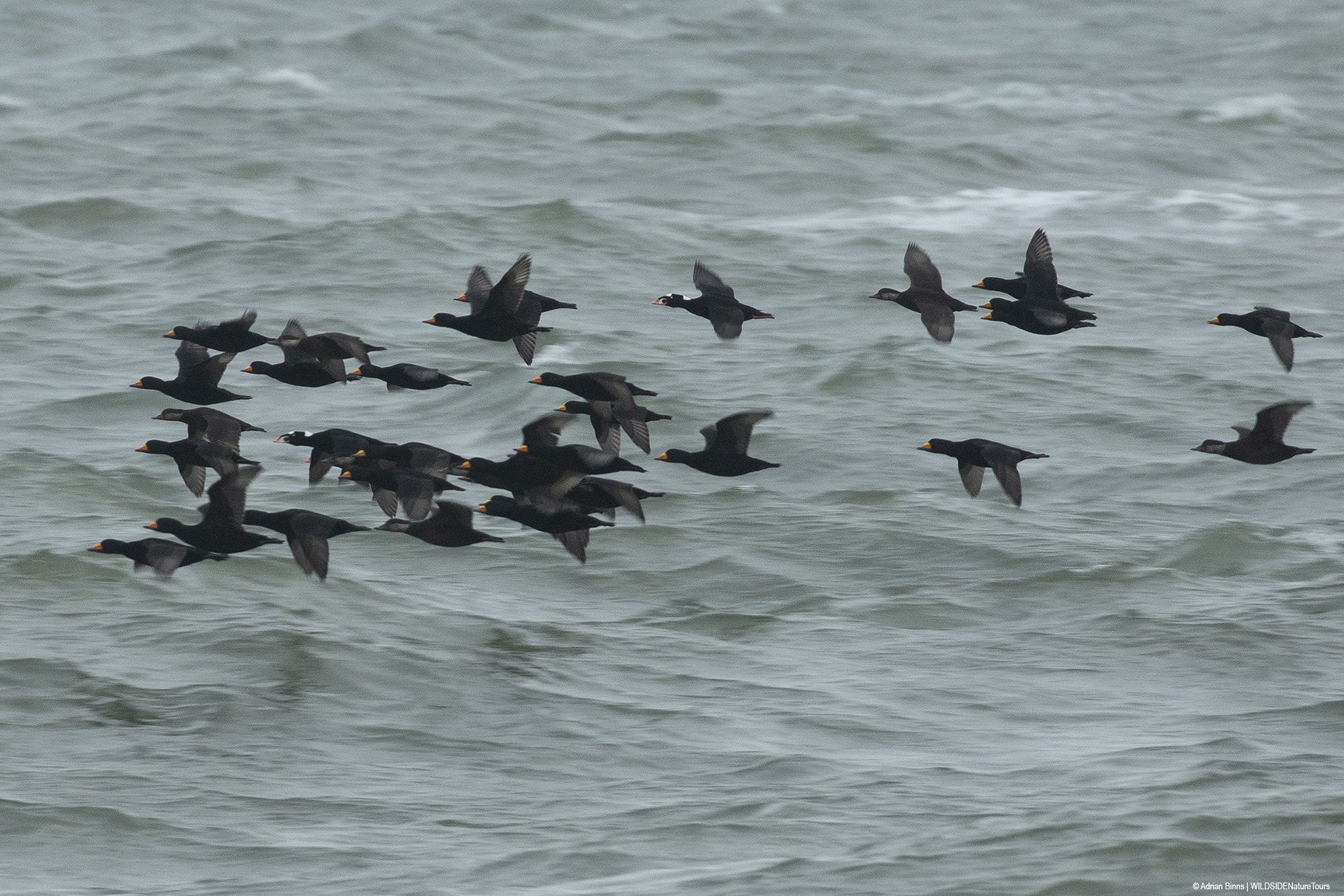Birding Cape May, New Jersey, is a treat any day of the year, but I especially enjoy the Autumn season, when crowds are thinner, but skies, seas, and shrubs are filled with birds. On October 28, Deb and I ventured down to explore a bit of this world-renowned hotspot. A little after sunrise, though it was overcast, we met Alex Lamoreaux at the Coral Avenue overlook, and were immediately surrounded by birds. An observation deck situated atop a vegetated sand dune affords great views of birds flying over the neighborhood on one side, and the beach and ocean on the other side.

‘Myrtle’ Yellow-rumped Warbler
Here, the confluence of the Delaware River and the Atlantic Ocean, birds come and go in all directions during fall migration. Large flocks of American Robins and Pine Siskins swirled overhead, while Golden-crowned and Ruby-crowned Kinglets, Red-breasted Nuthatches, and Northern Mockingbirds moved through shrubs and trees. Hundreds of Yellow-rumped Warblers chipped and flitted everywhere. A Dicksissel flew over calling. Cooper’s and Sharp-shinned Hawks patrolled the skies, along with American Kestrel, Merlin, and an immature Peregrine Falcon that swooped so low, we could see it’s shiny legband. Ospreys moved along the shoreline, and Northern Harrier quartered low along the dune scrub.
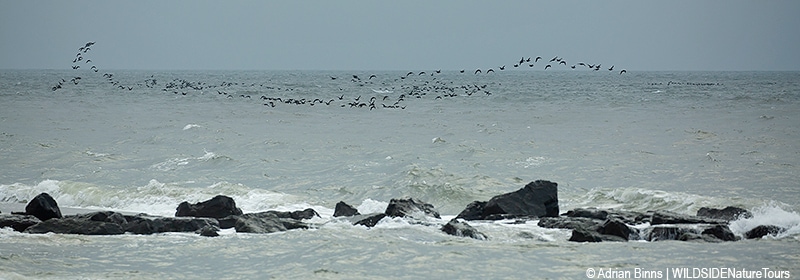
Scoters flying across ‘the Rips’
I walked across the beach to scan ocean waves, delighted that southern winds were pushing birds close to the shore for great viewing. Long skeins of scoters flew by at high-speed, going both directions. Black Scoters were most numerous, about 3-to-1 compared with Surf Scoters; three White-winged Scoters were picked-out from the flocks. Northern Gannets swooped and dove, while Forster’s and Royal Terns flew up and down the surf, calling and plunge-diving. A handful of Brant, along with Common Loon, Red-throated Loon, Northern Pintail, and a lone Common Eider were seen. Several Lesser Black-backed Gulls loafed on the beach, along with Great Black-backed, Herring, and a few Ring-billed Gulls.
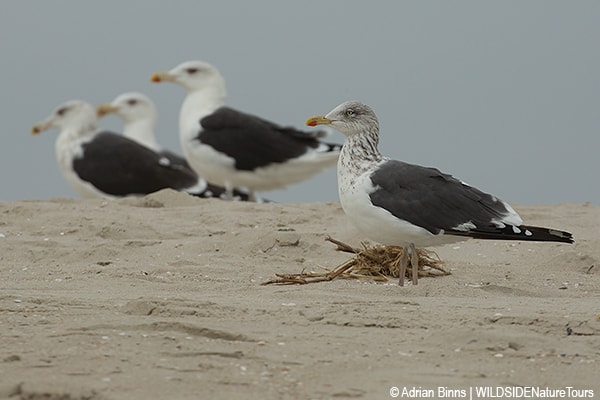
Great Black-backed Gulls and a Lesser Black-backed Gull (front right)
Time flies when you’re birding, and we moved on to the next stop, South Cape May Meadows, a Nature Conservancy property. It was a privilege to be invited to the banding station (closed to the public) to witness their morning activity. They were banding large numbers of Yellow-rumped Warblers, along with a few kinglets, a Brown Creeper, Lincoln’s Sparrow, and a surprise Sharp-shinned Hawk. The mist-nets are setup in corridors of marsh and meadow vegetation, so that data can be analyzed by different habitats. It was fascinating to observe the patient, efficient process, as they handled birds non-stop for hours!
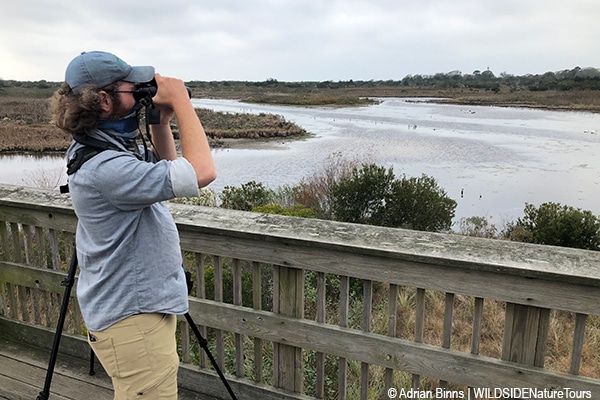
Alex birding the Meadows
A two-hour walk around the Meadows produced a wonderful variety of species. Ponds held Green-winged and Blue-winged Teal, American Wigeon, Northern Shoveler, American Black Duck, Northern Pintail, Ruddy Duck, and Mallards, along with Pied-billed Grebe, American Coot, and a few juvenile Common Gallinule. Wilson’s Snipe, Greater Yellowlegs, and an unexpected American Bittern flew up from the marsh. Siskins continued flying over – usually heard before seen, and sparrows popped up from trail edges, including Swamp, Field, Savannah, Song and abundant White-throated Sparrows. Brown Thrasher and Northern Mockingbird call loudly. A stretch along the beach showed the same scoters, terns, and gulls as earlier, as well as a Dolphin breaching beyond the surf line.
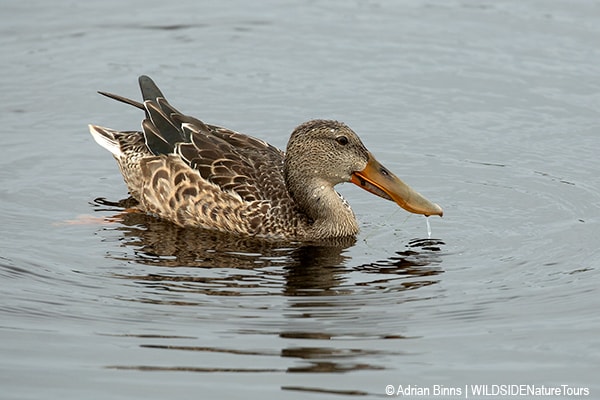
Northern Shoveler, female
The Cape May State Park is the best picnic lunch spot on the island, with restrooms, pavilions, and non-stop birds! After eating sandwiches at a table, we walked up to the Hawkwatch platform to scan the skies, and check Bunker Pond. Counter Tom Reed and the Cape May Bird Observatory staff naturalist pointed out Red-shouldered Hawk, Cooper’s and Sharp-shinned Hawks, and Peregrine Falcon overhead. Waterfowl included Blue-winged and Green-winged Teal, American Wigeon, Northern Pintail, Gadwall, a large raft of American Coot, and a Pied-billed Grebe.
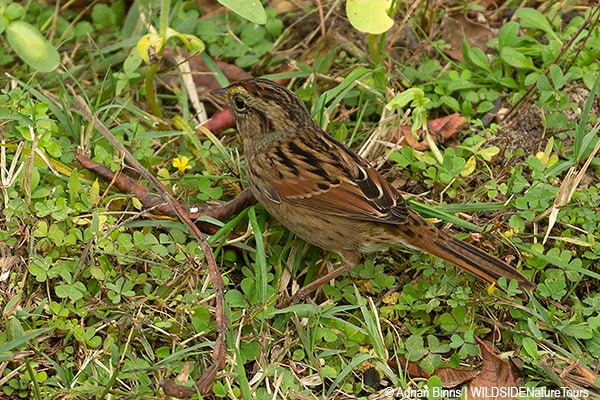
Swamp Sparrow
The hawkwatch platform is ringed by a mowed-grass strip and dense shrubs. Kinglets flit around, and sparrows venture down onto the grass for seeds, including White-crowned, Swamp, Song, and White-throated Sparrows. A Eurasian Wigeon paddled with nearly a hundred American Wigeon on the nearby Lighthouse Pond.

Gulls at Cape May Point
We ended a fall day in Cape May with a tally of 90 species, and a cold, refreshing beverage at “Exit Zero” – a lovely eatery at the bottom of New Jersey. Cape May is wonderful in so many ways – plan your visit soon!
